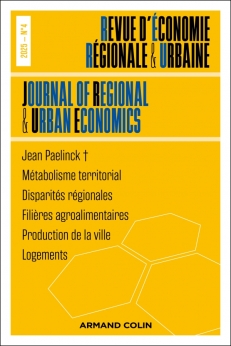
REVUE D'ÉCONOMIE RÉGIONALE ET URBAINE (4/2025)
Pour acheter ce numéro, contactez-nous
Recevez les numéros de l'année en cours et accédez à l'intégralité des articles en ligne.
Cet article analyse la dépendance spatiale des indices de pauvreté monétaire et divers indicateurs socio-économiques à partir d’un modèle Durbin spatial (SDM) et de données de panel couvrant les périodes 2008, 2015 et 2018. Les résultats indiquent globalement que l’effet de débordement de l’incidence de la pauvreté n’est pas significatif à l’échelle régionale. En revanche, les effets de débordement des indices de profondeur et de sévérité de la pauvreté sont négatifs et significatifs. L’éducation, l’emploi, l’accès à l’électricité et à l’eau potable, la croissance urbaine et la densité sont associés à la réduction de la pauvreté, produisant pour la plupart des externalités positives. La taille des ménages et l’absence de toilettes améliorées sont associées à une augmentation de la pauvreté et produisent des externalités négatives. Ces résultats corroborent la nécessité de prendre en compte les dépendances spatiales dans la formulation des stratégies de lutte contre la pauvreté.
This article analyses the spatial dependence of monetary poverty indices and various socio-economic indicators using a spatial Durbin model (SDM) and panel data covering 2008, 2015 and 2018. The value of this analysis is crucial, as it provides a better understanding of the impact of regional dynamics on poverty and enables better-targeted development policies to be devised and adapted to local realities. Analysis of spatial autocorrelation using the Moran index indicates spatial clustering and positive autocorrelation of poverty indices and other socio-economic variables. In addition, econometric tests confirm an autocorrelation of errors, thus justifying the effectiveness of the SDM model coefficients in controlling the autocorrelation. Overall, the results indicate that the spillover effect of the incidence of poverty is not significant at the regional level. On the other hand, the spillover effects of the depth and severity of poverty indices are negative and significant. Education, employment, access to electricity and drinking water, urban growth, and density are associated with poverty reduction, mainly producing positive externalities. Household size and the absence of improved toilets are associated with increased poverty and produce negative externalities. The spatial dependence of socio-economic phenomena, particularly geographical proximity, underscores the need for balanced regional development to ensure a better distribution of the fruits of economic growth.